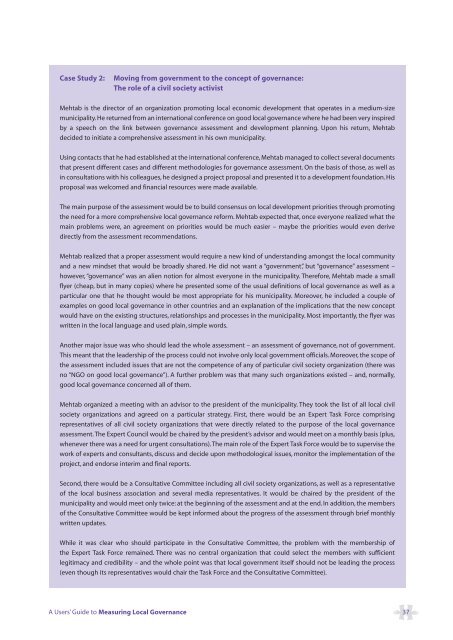A Users' Guide to Measuring Local Governance
A Users' Guide to Measuring Local Governance
A Users' Guide to Measuring Local Governance
You also want an ePaper? Increase the reach of your titles
YUMPU automatically turns print PDFs into web optimized ePapers that Google loves.
Case Study 2:<br />
Moving from government <strong>to</strong> the concept of governance:<br />
The role of a civil society activist<br />
Mehtab is the direc<strong>to</strong>r of an organization promoting local economic development that operates in a medium-size<br />
municipality. He returned from an international conference on good local governance where he had been very inspired<br />
by a speech on the link between governance assessment and development planning. Upon his return, Mehtab<br />
decided <strong>to</strong> initiate a comprehensive assessment in his own municipality.<br />
Using contacts that he had established at the international conference, Mehtab managed <strong>to</strong> collect several documents<br />
that present different cases and different methodologies for governance assessment. On the basis of those, as well as<br />
in consultations with his colleagues, he designed a project proposal and presented it <strong>to</strong> a development foundation. His<br />
proposal was welcomed and financial resources were made available.<br />
The main purpose of the assessment would be <strong>to</strong> build consensus on local development priorities through promoting<br />
the need for a more comprehensive local governance reform. Mehtab expected that, once everyone realized what the<br />
main problems were, an agreement on priorities would be much easier – maybe the priorities would even derive<br />
directly from the assessment recommendations.<br />
Mehtab realized that a proper assessment would require a new kind of understanding amongst the local community<br />
and a new mindset that would be broadly shared. He did not want a “government”, but “governance” assessment –<br />
however, “governance” was an alien notion for almost everyone in the municipality. Therefore, Mehtab made a small<br />
flyer (cheap, but in many copies) where he presented some of the usual definitions of local governance as well as a<br />
particular one that he thought would be most appropriate for his municipality. Moreover, he included a couple of<br />
examples on good local governance in other countries and an explanation of the implications that the new concept<br />
would have on the existing structures, relationships and processes in the municipality. Most importantly, the flyer was<br />
written in the local language and used plain, simple words.<br />
Another major issue was who should lead the whole assessment – an assessment of governance, not of government.<br />
This meant that the leadership of the process could not involve only local government officials. Moreover, the scope of<br />
the assessment included issues that are not the competence of any of particular civil society organization (there was<br />
no “NGO on good local governance”). A further problem was that many such organizations existed – and, normally,<br />
good local governance concerned all of them.<br />
Mehtab organized a meeting with an advisor <strong>to</strong> the president of the municipality. They <strong>to</strong>ok the list of all local civil<br />
society organizations and agreed on a particular strategy. First, there would be an Expert Task Force comprising<br />
representatives of all civil society organizations that were directly related <strong>to</strong> the purpose of the local governance<br />
assessment. The Expert Council would be chaired by the president’s advisor and would meet on a monthly basis (plus,<br />
whenever there was a need for urgent consultations).The main role of the Expert Task Force would be <strong>to</strong> supervise the<br />
work of experts and consultants, discuss and decide upon methodological issues, moni<strong>to</strong>r the implementation of the<br />
project, and endorse interim and final reports.<br />
Second, there would be a Consultative Committee including all civil society organizations, as well as a representative<br />
of the local business association and several media representatives. It would be chaired by the president of the<br />
municipality and would meet only twice: at the beginning of the assessment and at the end. In addition, the members<br />
of the Consultative Committee would be kept informed about the progress of the assessment through brief monthly<br />
written updates.<br />
While it was clear who should participate in the Consultative Committee, the problem with the membership of<br />
the Expert Task Force remained. There was no central organization that could select the members with sufficient<br />
legitimacy and credibility – and the whole point was that local government itself should not be leading the process<br />
(even though its representatives would chair the Task Force and the Consultative Committee).<br />
A Users’ <strong>Guide</strong> <strong>to</strong> <strong>Measuring</strong> <strong>Local</strong> <strong>Governance</strong> 37








![GuÃa del Usuario ] - Governance Assessment Portal](https://img.yumpu.com/44740603/1/190x253/gua-a-del-usuario-governance-assessment-portal.jpg?quality=85)







